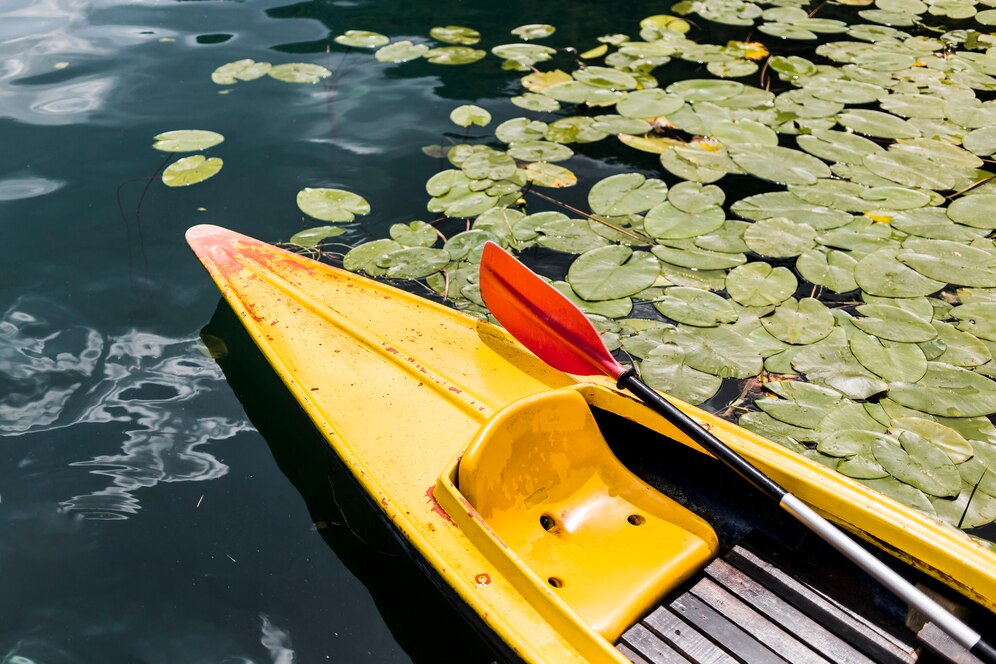
Tessa Young
Kayak Expert

John Smith
![]() Expert Reviewed |Kayak Expert
Expert Reviewed |Kayak Expert
[timeanddate]
Kayaking offers an exhilarating way to connect with nature, providing both adventure and tranquility on the water. However, your experience can be greatly influenced by the equipment you use, particularly the paddle. Choosing the right kayak paddle is not just about convenience but also about enhancing your performance and comfort. This guide will delve into the nuances of selecting the perfect paddle to ensure you have an enjoyable and efficient kayaking experience.
On This Page
- 1 Why Choosing the Right Kayak Paddle Matters
- 2 Types of Kayak Paddles
- 3 Different Kayak Paddle Blade Shapes
- 4 Materials Matter: Choosing the Right Paddle Material
- 5 Paddle Length: How to Measure and Choose
- 6 Shaft Design and Grip
- 7 Feathering: What It Is and Why It Matters
- 8 Weight and Balance: Key Considerations
- 9
- 10 Paddle Leashes: Why They’re Essential for Kayaking
- 11 Common Mistakes to Avoid When Choosing a Paddle
- 12 Bottom Line
- 13 FAQS:
- 14 About Author
Why Choosing the Right Kayak Paddle Matters
The kayak paddle is your primary means of propulsion and control. The right paddle can enhance your efficiency, reduce fatigue, and ensure a smoother, more enjoyable ride. Conversely, an ill-suited paddle can lead to discomfort, inefficient strokes, and even injury. By understanding the various types of paddles and their specific uses, you can make an informed decision that complements your kayaking style and needs.

Types of Kayak Paddles
Touring Kayak Paddles:
Touring paddles are designed for long-distance kayaking. They’re lightweight and efficient, allowing you to paddle for hours without tiring your arms. These paddles usually have a longer, slimmer blade, which makes them ideal for calm lakes, slow-moving rivers, or sea kayaking.
Whitewater Kayak Paddles:
Whitewater paddles are built to handle the rough conditions of fast-flowing rivers and rapids. They are shorter with larger, more durable blades, providing powerful strokes and quick maneuverability. These paddles are tough, able to withstand the impacts and stresses of turbulent waters.
Recreational Kayak Paddles:
Recreational paddles are perfect for those who enjoy casual paddling in calm waters, like small lakes and slow rivers. They strike a balance between performance and comfort, making them ideal for beginners or those who kayak occasionally. These paddles are generally affordable and easy to use.
Performance Kayak Paddles:
Performance paddles are designed for those who are serious about kayaking, whether it’s for racing or improving your speed and efficiency on the water. They are often made from high-end materials like carbon fiber, making them extremely light and responsive, allowing for quick, precise strokes.
Fishing Kayak Paddles:
Fishing paddles are tailored for anglers who need to maneuver quietly and efficiently while focusing on their catch. These paddles often feature a slightly wider blade for added stability and sometimes include features like a built-in ruler or hook retrieval notch, making them a handy tool for fishing enthusiasts.
Kayak Width | Under 23" | 23" to 27.75" | 28" to 32" | Over 32" |
Paddler Height | Recommended Paddle Length | |||
Under 5' | 200 cm | 210 cm | 220 cm | 230 cm |
5' to 5'6" | 210 cm | 220 cm | 230 cm | 240 cm |
5'7" to 6' | 220 cm | 220 cm | 230 cm | 240 cm |
Over 6' | 220 cm | 230 cm | 240 cm | 250 cm |
Different Kayak Paddle Blade Shapes
High Angle Paddle:
A high-angle paddle is designed for more aggressive and powerful strokes. The blade is shorter and wider, allowing for a vertical stroke that gives you more control and speed. It’s great for those who want to paddle quickly or in rougher waters where you need extra power.
Low Angle Paddle:
Low-angle paddles have longer, narrower blades that are ideal for a more relaxed paddling style. The blade enters the water at a shallow angle, which is easier on the shoulders and perfect for long, steady trips. This style is great for touring or for paddlers who prefer a more leisurely pace.
Wing-Shaped Blade:
Wing-shaped blades are specialized paddles often used in racing or by those looking for maximum efficiency. The blade’s shape resembles an airplane wing, which helps to create lift as it moves through the water, allowing for a more powerful and efficient stroke. This design can take some time to master but is ideal for speed.
Greenland Paddles:
Greenland paddles have long, slender blades and are deeply rooted in traditional Inuit design. They are known for being gentle on the body and offer a quiet, smooth paddling experience. These paddles are versatile and work well in various conditions, making them a favorite for many experienced paddlers who appreciate their connection to traditional kayaking.
Dihedral Blades:
Dihedral blades feature a slight V-shaped groove down the center of the blade. This design helps to direct water smoothly off both sides of the blade, reducing flutter and making the paddle easier to control. It’s a popular choice for beginners or anyone looking for a stable and predictable stroke.
Materials Matter: Choosing the Right Paddle Material
When choosing a kayak paddle, the material is crucial as it affects performance, comfort, and durability. Here’s a breakdown of the most common materials:
1. Aluminum: Affordable and Durable
Aluminum paddles are a popular choice due to their affordability and durability. They’re strong and can handle rough conditions, making them ideal for beginners or casual paddlers. However, they can be heavier than other materials and may not be as comfortable for long trips.
2. Fiberglass: Lightweight and Efficient
Fiberglass paddles strike a balance between weight and performance. They are lighter than aluminum and offer better efficiency on the water. They provide a good amount of flex, which can reduce strain on your arms and shoulders, making them suitable for those who paddle frequently.
3. Carbon Fiber: High Performance and Lightweight
Carbon fiber paddles are the top choice for serious kayakers. They are incredibly lightweight and offer exceptional strength. The reduced weight enhances speed and control, making them ideal for competitive paddling or long-distance trips. They come at a higher price, but many find the performance boost worth the investment.
4. Wood: Classic and Aesthetic Appeal
Wooden paddles are valued for their classic look and natural feel. They offer a unique aesthetic appeal and can be custom-made to fit your preferences. While they may require more maintenance to keep in good shape, many paddlers appreciate the traditional craftsmanship and the connection to the sport’s history.
5. Plastic: Cost-effective and Durable
Plastic paddles are the most budget-friendly option. They are durable and resistant to damage, making them a good choice for beginners or recreational paddlers. While they may not offer the same performance as other materials, they are practical and reliable for casual use.
Paddle Length: How to Measure and Choose
When choosing the right paddle length for kayaking, you need to measure yourself and consider your kayak’s dimensions. To measure, sit in your kayak or a similar position. Extend your arms and hold a paddle vertically.
The blade should reach the water comfortably. The general rule is to choose a paddle length that allows you to maintain a relaxed and efficient stroke without straining. For most people, this is typically between 210 and 240 cm. Remember, personal comfort and the type of kayaking you plan to do also play significant roles.
Factors Influencing Paddle Length
Several factors can influence the ideal length of your kayak paddle. Your height is crucial; taller paddlers generally need longer paddles. The width of your kayak is also important; wider kayaks often require longer paddles to reach the water comfortably. Additionally, the type of kayaking you do matters.
For example, sea kayaks often use longer paddles for better reach, while whitewater kayaks use shorter paddles for quick maneuverability. Your personal stroke style and preferences will also affect the ideal length.
Paddle Length for Different Kayak Types
Different types of kayaks often require different paddle lengths. For touring or sea kayaks, which are longer and narrower, a longer paddle (around 220-240 cm) is usually better for a more comfortable stroke and efficient propulsion.
For recreational kayaks, which are generally wider, a medium-length paddle (about 210-230 cm) works well. Whitewater kayaks, which are shorter and more compact, typically use shorter paddles (around 190-210 cm) for quick and agile movements. Always consider the specific design and intended use of your kayak when choosing your paddle length.
Adjustable vs. Fixed-Length Paddles
When choosing between adjustable and fixed-length paddles, consider your needs and preferences. Adjustable paddles allow you to change the length depending on different conditions or personal preferences, making them versatile and convenient for varied kayaking styles.
Fixed-length paddles, on the other hand, are often lighter and more durable, but you must choose the right length for your specific needs from the start.
If you kayak in different conditions or with different types of kayaks, an adjustable paddle might be the best choice. If you have a specific style and set-up, a fixed-length paddle can offer more stability and efficiency.
Paddler Height | Paddle Length |
Under 5'2" | 191 cm |
5'2" - 5'8" | 194 cm |
5'8" - 6'0" | 197 cm |
6'0" - 6'2" | 200 cm |
6'3" and over | 203 cm |
Shaft Design and Grip
When it comes to kayaking, the design of your paddle’s shaft and grip can make a big difference. The shaft is the long, straight part of the paddle you hold, and the grip is the section where your hands rest.
A good shaft design can help you paddle more efficiently and comfortably. It’s important that the shaft feels right in your hands and doesn’t cause unnecessary strain. The grip should be comfortable and provide good control so you can maneuver your kayak easily.
Straight Shaft vs. Bent Shaft
Kayak paddles come with two main types of shafts: straight and bent.
Straight Shaft: This is the most common type and is what many people are familiar with. It’s simple and works well for most paddlers. However, it might not be the best choice for everyone, especially if you have specific needs or preferences.
Bent Shaft: This type of shaft is curved to match the natural angle of your hands and arms. It can be more comfortable and reduce strain on your wrists and shoulders. If you’re paddling for long periods, a bent shaft might be a better option.
Choosing the Right Shaft Diameter
The diameter of the paddle shaft affects how comfortable it is to hold and how well you can control the paddle.
Thin Shafts: These are generally lighter and can be easier to grip for people with smaller hands. They are great for shorter paddling sessions.
Thick Shafts: These provide a more solid grip and are better for larger hands. They can be more comfortable for longer trips, but might feel heavy to some paddlers.
Grip Materials and Comfort
The material of the paddle grip can greatly impact your comfort while kayaking. Common materials include:
Rubber: Offers a soft, cushioned feel and is great for absorbing shock. It’s usually good for long paddling trips.
Plastic: Durable and easy to clean, but may not be as comfortable as rubber. It’s a good choice for casual paddlers.
Cork: Provides a natural feel and is very comfortable. It’s also lightweight but can wear out faster.
Feathering: What It Is and Why It Matters
Feathering refers to the angle at which the two blades of a kayak paddle are set relative to each other. When you feather your paddle, one blade is angled differently from the other. This design helps reduce wind resistance and makes paddling more efficient.
Feathering is important because it can make your paddling smoother and less tiring. Without feathering, the flat side of the blade can catch the wind, which can slow you down and make paddling harder. Feathered paddles are designed to slice through the wind more easily, which is especially useful in windy conditions.
Advantages of Feathered Paddles
Reduced Wind Resistance: The angled blades cut through the wind more easily, which helps you paddle faster and with less effort.
Improved Efficiency: With less wind resistance, you can maintain a steadier pace and reduce the strain on your arms and shoulders.
Better Control: Feathered paddles often provide better control and maneuverability, especially when dealing with strong winds or changing water conditions.
How to Adjust Feathering Angle
Locate the Adjuster: Most paddles with feathering have a small adjuster or button on the shaft. This allows you to change the angle of the blades.
Set the Angle: Use the adjuster to set the angle that feels most comfortable for you. Common angles range from 0 to 60 degrees.
Test and Fine-tune: Try paddling with the new angle and see how it feels. You might need to make small adjustments until you find the right setting for your style and the conditions you’re paddling in.
Weight and Balance: Key Considerations
When kayaking, the weight and balance of your gear are crucial for a smooth and enjoyable experience. The weight of your kayak affects how easy it is to handle and maneuver. A lighter kayak is easier to transport and paddles more easily, but it might not be as stable. On the other hand, a heavier kayak can offer better stability but might be more challenging to carry.
Balance is equally important. A well-balanced kayak will feel more stable on the water, reducing the chances of tipping over. To achieve the best balance, make sure your kayak is evenly loaded and that your gear is distributed properly. Remember, a kayak that’s balanced correctly will make your paddling more efficient and less tiring.
Why Paddle Weight Matters
Paddle weight plays a significant role in your kayaking experience. A lighter paddle reduces the effort needed for each stroke, making it easier to paddle for longer periods without getting fatigued. This is particularly important for long trips or when you’re paddling in challenging conditions.
On the flip side, a heavier paddle can offer more power per stroke, which can be beneficial for quick bursts of speed or for dealing with strong currents. However, this added weight can also make paddling more strenuous over time. Choosing the right paddle weight depends on your personal preference, the type of kayaking you do, and how much effort you’re willing to exert.
Finding the Right Balance for Comfort
Finding the right balance in your kayak is key to a comfortable paddling experience. When your kayak is well-balanced, you’ll feel more stable and less fatigued. To achieve this, start by adjusting the seating position and ensure that your weight is evenly distributed.
Additionally, your paddle should be the right length and weight for your height and strength. A well-balanced setup allows you to use your body effectively, reducing strain on your muscles and joints. Test different configurations and make adjustments until you find the setup that feels best for you. Comfort in your kayak leads to a more enjoyable and successful paddling experience.
Paddle Leashes: Why They’re Essential for Kayaking
A paddle leash is a handy accessory that keeps your paddle attached to your kayak, preventing it from drifting away if you accidentally drop it. This small but crucial tool helps you stay safe and ensures you can easily retrieve your paddle without needing to swim back to it. Paddle leashes are especially useful in rough waters or for beginners who might not yet have perfect control. By securing your paddle, you reduce the risk of losing it and can focus more on enjoying your time on the water.
Drip Rings: Keeping You Dry
Drip rings are simple accessories that help keep water from dripping down the shaft of your paddle and onto your kayak or yourself. These rings fit around the paddle shaft near the blades and catch the water that runs off, minimizing splashes and keeping you drier.
They are particularly useful during long paddling trips when staying dry can make a big difference in comfort. Installing drip rings is an easy and effective way to improve your paddling experience and maintain a more comfortable and enjoyable ride.
Paddle Floats: Your Safety Lifesaver
Paddle floats are inflatable devices that you attach to your paddle to help stabilize your kayak if you capsize. They work by providing extra buoyancy, allowing you to use the paddle as a support to help you get back into your kayak.
This tool is vital for solo kayakers or in challenging conditions where a quick recovery is necessary. By using a paddle float, you can increase your chances of a successful self-rescue and continue your adventure with greater peace of mind.
Common Mistakes to Avoid When Choosing a Paddle
When selecting a kayak paddle, making the right choice can significantly impact your paddling experience. Here are some common mistakes to avoid:
Overlooking Paddle Length
One of the most common mistakes is not considering the right paddle length. Paddle length affects your comfort and efficiency. If the paddle is too long, it can be cumbersome and affect your stroke technique. Conversely, a paddle that’s too short might not give you enough reach or power. To find the right length, consider your kayak’s width and your paddling style. Generally, a wider kayak requires a longer paddle.
Ignoring Weight and Balance
The weight of the paddle plays a crucial role in your comfort and performance. A heavier paddle can tire you out quickly and make long trips more strenuous. Balance is equally important; a well-balanced paddle ensures smoother strokes and less fatigue. When choosing a paddle, look for one that offers a good balance between weight and sturdiness. Carbon or lightweight fiberglass paddles are often favored for their balance and reduced weight.
Choosing the Wrong Blade Shape
The blade shape of your paddle affects your stroke efficiency and how much power you can generate. Different blade shapes are designed for various paddling styles and conditions.
For example, a broader blade offers more power for aggressive paddling but might feel cumbersome in calm waters. On the other hand, a narrower blade is better for more technical paddling and offers less resistance. Make sure to choose a blade shape that matches your kayaking style and the types of water you’ll be navigating.
Bottom Line
Choosing the perfect kayak paddle is a blend of science and personal preference. By understanding the various types, materials, and features, you can make an informed decision that enhances your kayaking experience. Whether you’re navigating serene lakes or tackling wild rapids, the right paddle can make all the difference. Enjoy your adventures with the confidence that you have chosen the best paddle for your needs.
FAQS:
How to select a proper kayak paddle?
Selecting the right kayak paddle depends on a few factors: your height, the width of your kayak, and your paddling style. Generally, taller paddlers or those with wider kayaks need longer paddles. If you prefer a high-angle stroke, go for a shorter paddle; if you use a low-angle stroke, a longer paddle is better. Comfort is key, so try different paddles to see what feels right in your hands.
Which is better: fiberglass or carbon kayak paddle?
Both fiberglass and carbon paddles have their strengths. Fiberglass paddles are durable and offer a good balance of weight and performance, making them a solid choice for recreational kayakers. Carbon paddles are lighter and more rigid, providing better efficiency and less fatigue on long trips, but they tend to be more expensive. If you paddle frequently or go on long expeditions, the investment in a carbon paddle could be worthwhile.
Is it better to have a longer or shorter kayak paddle?
The length of your kayak paddle should match your body and kayak dimensions. A longer paddle is better for wider kayaks or if you use a low-angle stroke, which is less tiring and more efficient for long distances. A shorter paddle is ideal for narrower kayaks or if you prefer a high-angle stroke, which gives more power and control, especially in rough waters. Finding the right balance is crucial for comfort and performance.
Are expensive kayak paddles worth it?
Expensive kayak paddles are often worth the investment, especially if you paddle frequently or for long durations. Higher-priced paddles are usually made from lightweight, durable materials like carbon fiber, which reduce fatigue and enhance performance. They also often feature ergonomic designs that can prevent strain and improve your paddling technique. For casual paddlers, a mid-range paddle may be sufficient, but serious kayakers often find that a premium paddle pays off in the long run.
How do I know if my kayak paddle is too short?
A kayak paddle that’s too short will cause you to lean or reach awkwardly with each stroke, leading to discomfort and inefficient paddling. If you find yourself hitting the sides of your kayak frequently or struggling to keep your strokes smooth and even, your paddle might be too short. Another sign is if your hands are too close together on the paddle shaft. Adjusting to a longer paddle can improve your posture, stroke efficiency, and overall paddling experience.
About Author

Tessa Young
Kayak Expert
Author information on kayak sites typically includes details about the writers who contribute to the content. This information can vary but commonly includes the author’s name, their background or expertise in kayaking, any relevant certifications or qualifications they may hold (such as kayak instructor certifications or wilderness first aid training), and sometimes a brief bio or personal statement about their experiences with kayaking.
Read More

John Smith
Expert Reviewed | Kayaks Expert
Author information on kayak sites typically includes details about the writers who contribute to the content. This information can vary but commonly includes the author’s name, their background or expertise in kayaking, any relevant certifications or qualifications they may hold (such as kayak instructor certifications or wilderness first aid training), and sometimes a brief bio or personal statement about their experiences with kayaking.
Read More





